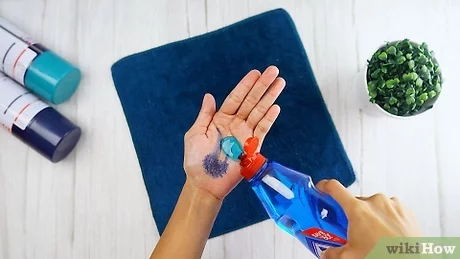Removing spray paint from skin can be a challenging task, especially if it has dried or if you have sensitive skin. This article will provide a comprehensive guide on how to effectively remove spray paint from skin using various methods, including both chemical and natural solutions. We will also discuss preventive measures, safety tips, and answer frequently asked questions about this topic.
Understanding Spray Paint
What is Spray Paint?
Spray paint is a type of paint that comes in a pressurized can, allowing for an even application over surfaces. It is commonly used for various projects, including arts and crafts, home improvement, and automotive repairs. However, its aerosol nature can lead to overspray, resulting in unwanted paint on skin.
Why is Spray Paint Difficult to Remove?
Spray paint is designed to adhere to surfaces, which makes it effective for its intended use but challenging to remove from skin. The paint can dry quickly, creating a bond with the skin that can be tough to break. Additionally, many spray paints contain solvents and chemicals that can irritate the skin if not handled properly.
Methods for Removing Spray Paint from Skin
Method 1: Using Oils
Fractionated Coconut Oil or Olive Oil
- Materials Needed:
- Fractionated coconut oil or olive oil
- Baking soda (optional)
- Soft cloth or paper towels
- Warm water
- Instructions:
- Apply a generous amount of oil to the affected area.
- Gently rub the oil into the skin to dissolve the paint.
- For stubborn spots, mix baking soda with the oil to create a paste and scrub gently.
- Rinse with warm water and wash with soap to remove any residue.
Method 2: Nail Polish Remover
- Materials Needed:
- Nail polish remover (acetone-based)
- Cotton balls or pads
- Soap and water
- Instructions:
- Soak a cotton ball in nail polish remover.
- Dab the cotton ball on the paint-stained area, allowing it to sit for a few moments.
- Gently rub the area until the paint begins to lift.
- Wash the area with soap and water to remove any remaining residue.
Method 3: Non-Stick Cooking Spray
- Materials Needed:
- Non-stick cooking spray
- Soft cloth or sponge
- Soap and water
- Instructions:
- Spray a generous amount of non-stick cooking spray on the paint-stained skin.
- Let it sit for a minute to loosen the paint.
- Use a soft cloth or sponge to gently scrub the area.
- Rinse with soap and water.
Method 4: Baby Oil or Mineral Oil
- Materials Needed:
- Baby oil or mineral oil
- Soft cloth or paper towels
- Soap and water
- Instructions:
- Apply baby oil or mineral oil to the stained area.
- Rub the oil into the skin to break down the paint.
- Wipe away the paint with a soft cloth.
- Wash the area with soap and water.
Method 5: Commercial Paint Removers
- Materials Needed:
- Commercial paint remover (skin-safe)
- Soft cloth
- Soap and water
- Instructions:
- Follow the manufacturer’s instructions on the paint remover.
- Apply the product to the affected area.
- Gently rub until the paint is removed.
- Rinse with soap and water.
Safety Precautions
- Patch Test: Before using any chemical product, perform a patch test on a small area of skin to check for adverse reactions.
- Avoid Harsh Chemicals: Stay away from products that contain harsh solvents that can irritate the skin.
- Protective Gear: When working with spray paint, wear gloves and protective clothing to minimize skin contact.
Preventive Measures
- Use Protective Gear: Always wear gloves and long sleeves when using spray paint to prevent overspray on skin.
- Work in a Controlled Environment: Spray paint in a well-ventilated area to reduce the risk of inhaling fumes and to control overspray.
- Practice Good Technique: Hold the spray can at the recommended distance from the surface and use steady strokes to minimize the chance of overspray.
FAQ Section
Q1: Can I use rubbing alcohol to remove spray paint from skin?
A1: Yes, rubbing alcohol can be effective in removing spray paint. Apply it to a cotton ball and gently rub the stained area until the paint lifts.
Q2: What should I do if I have sensitive skin?
A2: If you have sensitive skin, avoid harsh chemicals and opt for natural methods like using oils or baby oil to remove the paint.
Q3: How can I prevent spray paint from getting on my skin in the first place?
A3: Wear gloves and protective clothing, and practice good spraying techniques to minimize overspray.
Q4: Is it safe to use nail polish remover on skin?
A4: Nail polish remover can be used on skin, but it should be done sparingly and followed by washing the area with soap and water to prevent irritation.
Q5: What if the paint doesn’t come off after trying these methods?
A5: If the paint persists, consider consulting a dermatologist for advice on safe removal methods.
Table: Methods for Removing Spray Paint from Skin
| Method | Materials Needed | Instructions |
|---|---|---|
| Oils | Coconut oil or olive oil, baking soda | Apply oil, scrub gently, rinse with warm water. |
| Nail Polish Remover | Nail polish remover, cotton balls | Dab on the paint, rub gently, wash with soap. |
| Non-Stick Cooking Spray | Non-stick cooking spray | Spray, let sit, scrub with cloth, rinse with soap. |
| Baby Oil or Mineral Oil | Baby oil or mineral oil | Apply oil, rub in, wipe away paint, wash with soap. |
| Commercial Paint Removers | Commercial paint remover | Follow instructions, apply, rub, rinse with soap. |
Conclusion
Removing spray paint from skin can be a straightforward process if you use the right methods and materials. By acting quickly and employing natural or chemical solutions, you can effectively eliminate unwanted paint without damaging your skin. Remember to take preventive measures in the future to minimize the risk of overspray. If you experience any irritation or if the paint does not come off, consider seeking professional advice.For more information on skin care and safety, you can visit theNational Institutes of Health.



